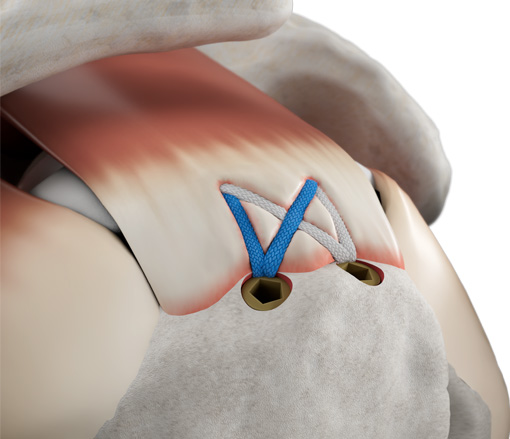Challenges of RCR Using Suture Anchors
Patient Outcomes
Current gold standard used for decades without significant improvement in patient outcomes
The original gold standard for rotator cuff repair (RCR) was an open repair using suture-bone tunnels to compress the cuff to head of the humerus which demonstrated good biomechanical properties resulting in reliable healing results.

Over the last decades, shoulder arthroscopy with the use of suture anchors has replaced previous techniques providing for faster recovery and better cosmetic results. As arthroscopy grew, suture anchors became the gold standard for tissue to bone fixation with the use of multiple anchors being widely accepted.1
The transition of many RCR’s from using transosseous tunnels to using suture anchors has shifted the weak link of the repair from the bone to the tendon with the common mode of failure seen now occurring at the suture-tendon interface.2
Throughout the years, various materials and techniques have been tried, but none have proved to be better than the others in terms of functional outcomes. As of today, there are still no guidelines indicating what to use and it is left to the surgeon to decide on surgical technique.3
Learn about SINEFIX for rotator cuff repair.
Suture Anchors
Use of suture anchors in arthroscopic RCR involves complex surgical technique
Multiple instruments, manual dexterity, and experience in suture management and knot tying are required for successful arthroscopic RCR. In addition, the use of multiple anchors increases complexity, surgical time and implant costs.
Common challenges:1
- Knot impingement with prolonged postoperative pain
- Suture-tension cut-through of tendon
- Anchor pull-out
- Cyst formation around anchors
- High financial costs
- Potential source of infection
Learn about SINEFIX for rotator cuff repair.
Retear Rates
Postoperative rotator cuff retear after rotator cuff repair is still a major problem
Recent comparative studies show no difference in retear rate when looking at different fixation techniques.5 Despite the advantages brought by the evolution of surgical techniques, the debate is still open regarding which surgical procedure and technique implies a lower retear rate after surgery.4
Surgical technique and retear rate:
Although single-row repair has produced favorable clinical outcomes, the retear rate is high.5 The double-row repair technique was developed to help decrease the retear rate with the goals of:
- Increasing fixation strength
- Decreasing gap formation under cyclic loading
- Improving the restoration of the anatomic footprint of the humeral head
Although numerous systematic reviews and meta-analyses have shown lower postoperative retear rate after double-row repair, knot-tying of the medial row of suture anchors can strangulate the tendon and impair vascular inflow, resulting in a type 2 retear.5 The use of double-row and suture-bridge techniques have been reported to increase the risk of medial cuff failure6
Learn about SINEFIX for rotator cuff repair.
Many things can affect retear rate such as: 4
- Patients’ age
- Preoperative tear size
- Diabetes
- Smoking
- Preoperative fatty infiltration and muscle atrophy
- Surgical procedure (e.g., arthroscopic, open, mini-open repairs)
- Fixation techniques (e.g., single-row, double-row, suture bridge, transosseous repairs)
Retear rates at different follow-up time points corresponding to diagnostic imaging assessments:4





REFERENCES:
1. Binder et al. Arthroscopic Anchorless Transosseous Rotator Cuff Repair Produces Equivalent Clinical Outcomes and Imaging Results as a Standard Suture Bridge Technique with Anchors. Arthroscopy, Sports Medicine, and Rehabilitation, Vol 4, No 6 (December), 2022: pp e2025-e2034.
2. Neeley et al. A Weaving Rip-Stop Technique Leads to a Significantly Increased Load to Failure and Reduction in Suture-Tendon Cut-Through in a Biomechanical Model of Rotator Cuff Repair. Arthroscopy, Sports Medicine, and Rehabilitation, Vol 3, No 5 (October), 2021: pp e1263-e1272.
3. De Giorgi et al. Single‑row versus transosseous technique in the arthroscopic treatment of rotator cuff tears: a meta‑analysis. European Journal of Orthopaedic Surgery & Traumatology. August 2023.
4. Longo et al. Retear rates after rotator cuff surgery: a systematic review and meta-analysis. BMC Musculoskeletal Disorders (2021) 22:749.
5. Prasathaporn et al. Types of Retears After Knot-tying and Knotless Suture Bridge Rotator Cuff Repair A Systematic Review and Meta-analysis. Orthop J Sports Med. 2022 Nov 25;10(11):23259671221135604.
6. Bedeir et al. Type 2 retear after arthroscopic single-row, double-row and suture bridge rotator cuff repair: a systematic review. Eur J Orthop Surg Traumatol. 2019 Feb;29(2):373-382.
